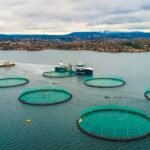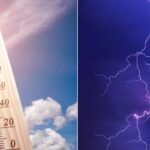A 10-acre wildfire raging in Fauldhouse, West Lothian, has triggered an extreme risk warning across mainland Scotland. Firefighters are battling intense flames in scorching, bone-dry conditions as environmental officials raise concerns about water scarcity.
Six fire engines and two specialist units remain at the scene, tackling a blaze that’s swallowed a wooded area roughly the size of five and a half football pitches.
Fauldhouse Fire Spreads Fast in Peak Season
The fire broke out late morning, just as authorities were warning of heightened wildfire threats due to Scotland’s unusually warm and dry spring.
Crews were called to the scene at 11:43am. By midday, flames were advancing through a dense patch of woodland measuring around 40,000 square metres.
One firefighter described the scene as “intense, relentless, and incredibly difficult to contain.”
Just one sentence: “It’s a large area of trees alight, it’s 200 metres by 200 metres,” an SFRS spokesperson said bluntly.
By mid-afternoon, acrid smoke had settled over parts of West Lothian, prompting warnings for locals to stay indoors and avoid affected roads.

Risk Level Raised to Extreme Until Monday
Scotland’s fire service, SEPA, and government agencies have collectively ramped up the alarm, issuing an Extreme wildfire warning across most of the mainland until Monday.
Conditions fuelling the fires have become all too familiar this spring.
-
Temperatures hit a record 23°C on April 5, the hottest day of the year so far.
-
SEPA reports widespread low river levels due to reduced rainfall.
-
Most wildfires in Scotland happen between March and May — and 80% are started by human activity.
The Scottish Fire and Rescue Service has called for “utmost caution” outdoors. Open flames, barbecues, and discarded cigarettes can become lethal in minutes under current conditions.
Burn Scars Across the Country Already
This isn’t the first major fire of the season — and likely won’t be the last.
In April, a helicopter was deployed to douse flames on the Isle of Bute, in a dramatic effort to contain a wildfire that threatened residential areas. Just a week later, Glentrool Forest in Galloway was evacuated as campers and hikers were rushed to safety.
Here’s a snapshot of wildfire damage reported in recent weeks:
| Location | Trees Destroyed | Evacuations | Firefighting Units |
|---|---|---|---|
| Isle of Arran | ~30,000 | No | Ground units only |
| Glentrool, Galloway | Unknown | Yes | Multiple crews |
| Isle of Bute | N/A | No | Helicopter + crews |
| Fauldhouse, West Lothian | Ongoing | No | 8 units on scene |
A forestry official on Arran called the damage “absolutely heartbreaking,” describing charred woodlands that may take generations to recover.
What’s Driving the Danger?
Scotland’s landscape is often imagined as rainy and cold, but the spring fire season paints a different picture.
A dry March and April have left peatlands, forests, and moorlands tinder-dry. And when the wind picks up, it’s like lighting a match near a pile of dry leaves.
Two sentences: Fire behaviour experts point to a dangerous mix — high temperatures, low humidity, and human carelessness. All it takes is one spark.
SFRS says it’s not just deliberate fires causing chaos. Accidental fires from careless walkers, disposable barbecues, and discarded glass bottles are a major problem.
“We can’t afford another careless mistake,” one senior firefighter warned bluntly.
Scotland’s Wildfire Numbers Are Climbing
On average, Scotland records around 170 wildfires each year. Most go unnoticed unless they threaten homes or lead to evacuations.
But climate data shows the pattern is shifting. Spring fires are becoming more frequent, more destructive, and harder to control.
The public is often unaware of the danger until it’s too late. That’s a problem, especially in countryside hotspots like the Highlands, West Lothian, and Dumfries and Galloway.
One-sentence paragraph: The fire season is no longer confined to summer.
Calls for Long-Term Strategy Grow Louder
As fires become more intense and more common, pressure is building on the Scottish Government to develop a long-term wildfire resilience plan.
Fire chiefs want more investment in wildfire training, equipment, and public awareness campaigns. Environmental scientists say land use needs to change, too.
One official with Forestry and Land Scotland said they’re already shifting toward “fire-resistant vegetation” in some replanting areas.
And rural leaders have called for stricter rules on public land use during dry spells. There’s growing support for temporary bans on open flames, even in picnic areas.
“We’re on the back foot here,” said a West Lothian councillor. “These fires are getting ahead of us.”


















